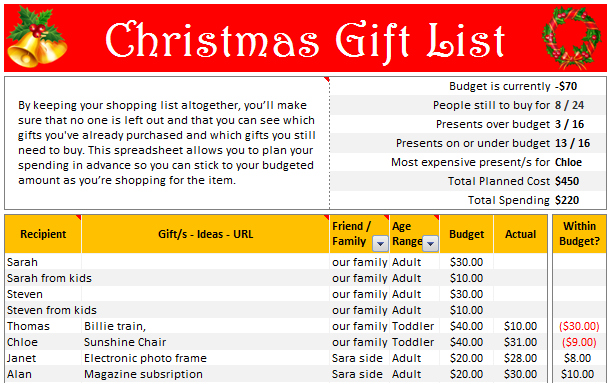Steven, one of our readers from England sent me a Christmas gift tracker worksheet. I found it pretty cool, so made some minor changes to it and am sharing it with you all so that you can have great time shopping for the holidays.

Why I found this Christmas Gift List Spreadsheet Cool?
There are probably a million other gift trackers out there, but I liked Steven’s version for few reasons:
- He used conditional formatting to zebra line the gift-table.
- He used array formulas to find-out who is receiving the most expensive gift. The formula relies on VLOOKUP coupled with SUBTOTAL so that when you filter the list to see gifts only for certain age group, the formula shows most expensive gift receiver in that group alone. How cool is that 😎
- He used cell formatting to highlight gifts overshooting budget in RED color.
- He used SUMPRODUCT liberally to summarize the gift data to show us “how many people got the gifts”, “how many gifts are over the budget”, “how many gifts are under-budget”.
Go ahead and download the workbook. Even if you dont have a huge list of gifts to buy this Christmas (REALLY ?!? You dont have a long list? Can I please, please get that wii?). The workbook is full of excel lessons on conditional formatting, formulas and design.
Download the Christmas Gift List Spreadsheet
Click here to download the file. It is protected to make sure you accidentally erase a formula or something. But there is no password. So go ahead and unlock it to learn something cool.
Thank you Steven,
for your most thoughtful and awesome Christmas gift to our community.




















4 Responses to “How windy is Wellington? – Using Power Query to gather wind data from web”
Breaking - Wind jokes at Chandoo
Kiwis sniffing for clues about blog post reason
It's confirmed: Wellington is windier than Uranus.
Acompanhando e aguardando ansiosamente a segunda parte.
[]s.
[Google translate]: Accompanying and eagerly awaiting the second part
hi chandoo,
i've tried using power query, however i face a rather weird problem. when i click on 'from web' option, the URL window does not show option for basic and advanced. thus i'm unable to form parameters in URL. how i can resolve this issue?